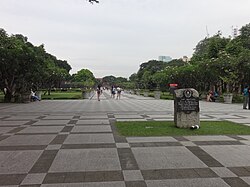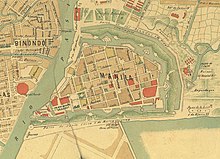
Intramuros, is the 0.67-square-kilometer (0.26 sq mi) historic walled area within the city of Manila, the capital of the Philippines. It is administered by the Intramuros Administration with the help of the city government of Manila.
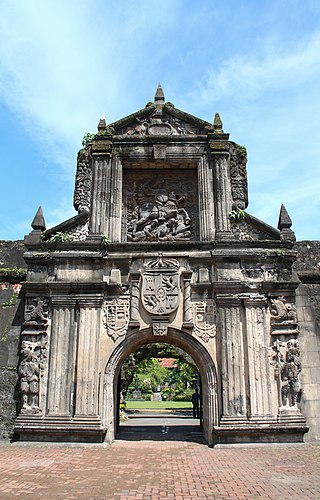
Fort Santiago, built in 1571, is a citadel built by Spanish navigator and governor Miguel López de Legazpi for the newly established city of Manila in the Philippines. The defense fortress is located in Intramuros, the walled city of Manila.

The Baroque Churches of the Philippines are a collection of four Spanish Colonial-era baroque churches in the Philippines, which were included in UNESCO's World Heritage List in 1993. The churches are also considered as national cultural treasures of the country.

The Manila Metropolitan Theater, also known as the Metropolitan Theater, abbreviated as the MET, is a historic Philippine Art Deco building located in Plaza Lawton in Ermita, Manila. It is recognized as the forefront of the Art Deco architectural style in the Philippines.
The gates of Intramuros refer to the original eight gates of the Walled City of Intramuros in Manila, built during the Spanish colonial era in the Philippines. The gates are called by the original Spanish word for "gate", puerta.

The William A. Jones Memorial Bridge, commonly known as the Jones Bridge, is an arched girder bridge that spans the Pasig River in the City of Manila, Philippines. It is named after the United States legislator William Atkinson Jones, who served as the chairman of the U.S. Insular Affairs House Committee which had previously exercised jurisdiction over the Philippines and the principal author of the Jones Law that gave the country legislative autonomy from the United States. Built to replace the historic Puente de España in the 1910s, the bridge connects Quintin Paredes Road at the Binondo district to Padre Burgos Avenue at the Ermita district.

Jaime del Carmen Laya, better known as Jimmy Laya is a Filipino banker, accountant, and cultural administrator who served as the first Secretary of the Department of Budget and Management of the Republic of the Philippines, serving from 1978 to 1981. He was also the 5th governor of the Central Bank of the Philippines from 1981 to 1984 and later served as the Minister of Education, Culture and Sports from 1984 until 1986. His terms in civil service, covered two significant points in Philippine history, the election that made former President Ferdinand Marcos have his third term and the assassination of the late Senator Benigno S. Aquino Jr. that stimulated the People Power Revolution of 1986.

Plaza de Roma, also known as Plaza Roma, is one of three major public squares in Intramuros, Manila. It is bounded by Andres Soriano Avenue to the north, Cabildo Street to the east, Santo Tomas Street to the south, and General Antonio Luna Street to the west. The plaza is considered to be the center of Intramuros.

Plaza Moriones is a major public square in Tondo, Manila. Unlike other squares in Manila, the plaza is in the shape of a linear park occupying the central median of Moriones Street, starting at the intersection of Moriones and Juan Luna Streets, and ending at the intersection with Santa Maria Street, bisected by Nicolas Zamora Street in the center. It is named after Governor-General Domingo Moriones y Muralla, responsible for the construction of Manila's sewerage system during his tenure from 1877 to 1881.

The Plaza de Armas is a public square in Intramuros, Manila. The central plaza of Fort Santiago, it is one of three major plazas in Intramuros, the others being the central Plaza de Roma outside the fort grounds, and Plaza Moriones, a larger plaza outside Fort Santiago which was once a military promenade before it was closed in the 1863 earthquake that devastated Manila. While Plaza Moriones is outside the walls of Fort Santiago, both plazas are often misconstrued for the other.
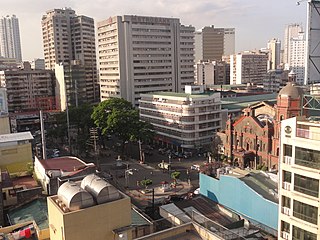
Plaza San Lorenzo Ruiz or Plaza Lorenzo Ruiz is a major public square in Binondo, Manila, bounded by Quintin Paredes Street to the east and Juan Luna Street to the west, parallel to the Estero de Binondo. It is the plaza that fronts the Minor Basilica of San Lorenzo Ruiz, one of the main churches of the City of Manila, and is considered the center of Binondo as a whole.

The Aduana Building, also known as the Intendencia, was a Spanish colonial structure in Manila, Philippines, that housed several government offices through the years. It is located in front of the BPI Intramuros at Plaza España, Soriano (Aduana) Ave. corner Muralla St. in Intramuros.

The Ayuntamiento de Manila is a building located at the corner of Andrés Soriano Avenue and Cabildo Street, fronting Plaza de Roma in Intramuros, Manila, Philippines. Also known as the Casas Consistoriales and also nicknamed as the Marble Palace, the Ayuntamiento was the seat of the Manila City Council, which consisted of two alcaldes, eight oidores (judges), a clerk, and a chief constable. Destroyed in World War II and reconstructed thereafter, the building now houses the offices of the Bureau of the Treasury.
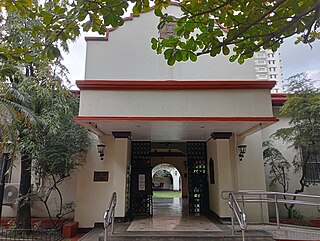
Casino Español de Manila is a club established in 1888 by Spaniards living in the Philippines as their exclusive venue for recreational and social activities. It later opened its doors to Filipino members to foster Spanish-Filipino ties in the country. It is located at No. 855 Teodoro M. Kalaw Extension, Ermita, Manila.

The Arroceros Forest Park is a riverside urban forest park in Manila, Philippines, located on Antonio Villegas Street in the central district of Ermita.

Plaza de España, also known simply as Plaza España, is a diminutive open space in Intramuros, Manila, Philippines formed by the intersection of Andres Soriano Avenue, Solana Street and Muralla Street. It is a triangular "square" which features a monument to King Philip II of Spain after whom the Philippines was named. The square is one of 47 parks and plazas in the City of Manila maintained by the city's Park Development Office in partnership with the Intramuros Administration. It is surrounded by the Aduana Building, the BPI Intramuros building which replaced the old Santo Domingo Church destroyed during World War II, and the Banco Filipino condominium building built on a portion of the old Ayuntamiento de Manila.

The National Museum of Natural History is the national natural history museum of the Philippines. It is located along Agrifina Circle in Rizal Park, Manila.
Museo de Intramuros is an ecclesiastical museum operated and managed by the Intramuros Administration. It is located at the reconstructed San Ignacio Church and Convent within the historic walled area of Intramuros in Manila, Philippines.
The Intramuros Administration (IA) is an agency of the Department of Tourism of the Philippines that is mandated to orderly restore, administer, and develop the historic walled area of Intramuros that is situated within the modern City of Manila as well as to insure that the 16th- to 19th-century Philippine-Spanish architecture remains the general architectural style of the walled area.

Plaza Rueda is a public square in Ermita, Manila, bounded by Taft Avenue to the west, United Nations Avenue to the north and General Luna Street to the east.
